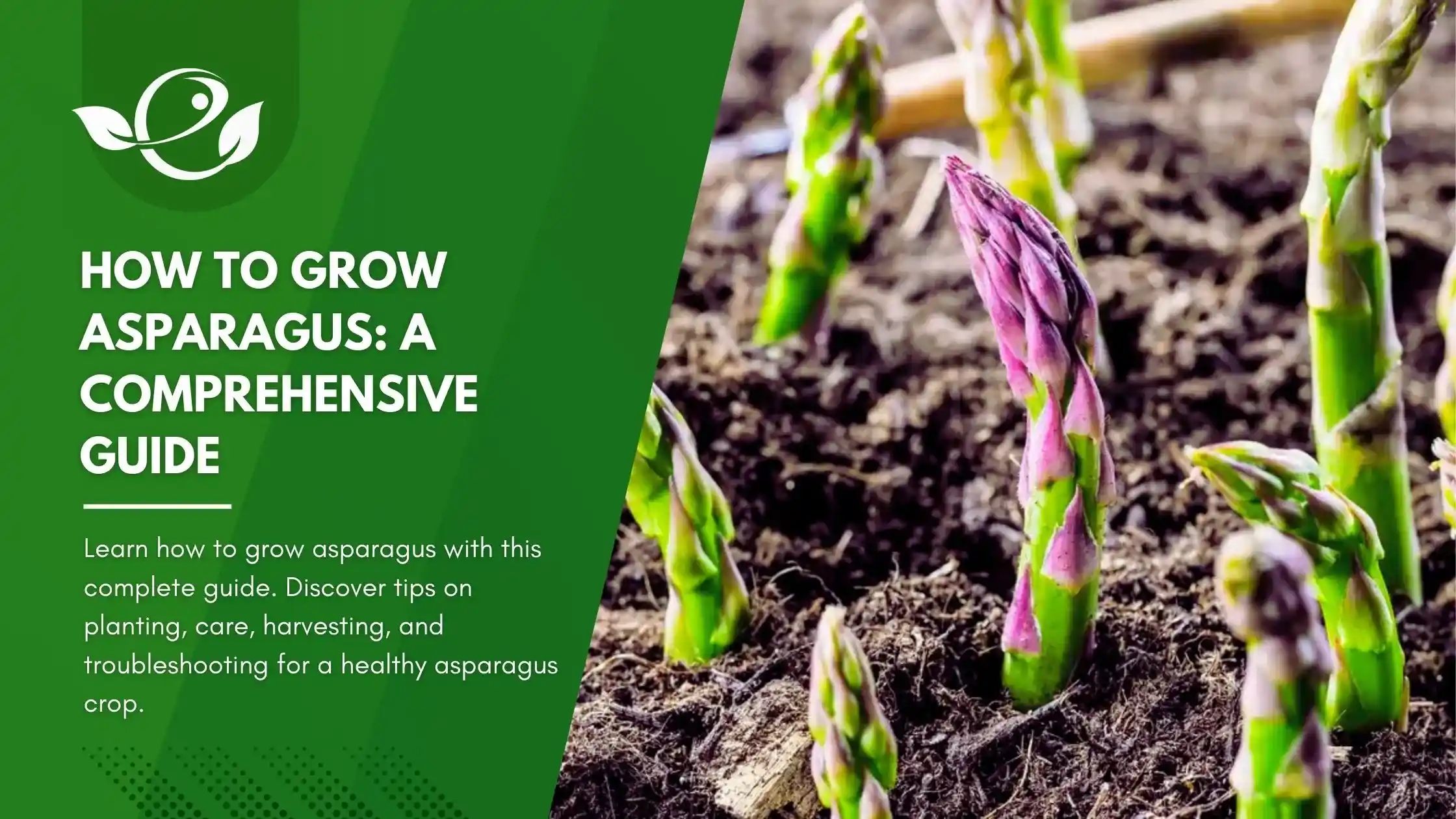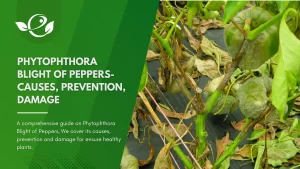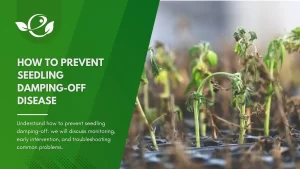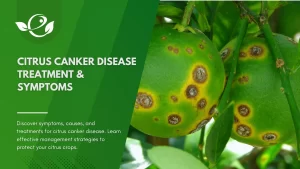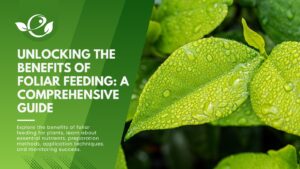Table of Contents
Asparagus (Asparagus officinalis) is a perennial vegetable celebrated for its tender spears and distinctive flavor. Asparagus is unique because it can produce edible spears for many years, often up to 20 years after being planted. This long lifespan makes it a valuable and rewarding crop for gardeners. In this comprehensive guide, we will walk you through how to grow asparagus, from choosing the right varieties and preparing the soil to planting, caring for, and harvesting this nutritious crop.
Why Grow Asparagus in Your Garden?
- Nutritional Benefits: Asparagus is rich in vitamins A, C, E, and K, as well as folate and fiber. It’s also a good source of antioxidants, which help combat free radicals in the body.
- Longevity: A well-maintained asparagus bed can produce spears for two decades or more, providing a long-term return on your initial planting investment.
- Sustainability: Once established, asparagus requires minimal maintenance and is relatively pest-resistant, making it an environmentally friendly crop choice.
Best Time and Conditions for Growing Asparagus
Asparagus is a perennial vegetable that thrives under specific conditions, ensuring a productive harvest for many years.
When to Plant:
- Early Spring Planting: The ideal time to plant asparagus crowns is in early spring, as soon as the soil can be worked. This timing allows the plants to establish roots before the onset of warmer temperatures.
- Soil Temperature: Asparagus begins to grow when soil temperatures reach around 60°F and 85°F (15°C to 29°C). Planting should occur when soil temperatures are conducive to root development but before the heat of late spring.
Ideal Climate Zones: Asparagus thrives in USDA Zones 3 through 8, performing best in areas with cool winters and long growing seasons.
Ideal Growing Conditions:
- Sunlight: Asparagus requires full sun, meaning at least 8 hours of direct sunlight daily. Insufficient light can lead to reduced spear production and weaker plants.
- Soil Requirements:
- Well-Drained Soil: Asparagus prefers well-drained soils to prevent root rot. Raised beds can be beneficial, especially in areas with heavy clay soils.
- Soil Type: While asparagus can adapt to various soil types, it thrives best in deep, fertile, sandy loam or loamy soils. These soil types provide the necessary nutrients and drainage for optimal growth.
- Soil pH: A neutral to slightly alkaline pH (6.5 to 7.5) is ideal. Conduct a soil test to determine pH levels and amend accordingly to create a hospitable environment for asparagus.
- Temperature: During the growing season, asparagus prefers daytime temperatures between 70°F to 85°F (21°C to 29°C) and nighttime temperatures between 60°F to 70°F (15°C to 21°C). Spears emerge in spring when soil temperatures reach 50°F (10°C).
Choosing the Right Asparagus Varieties
Selecting the appropriate asparagus variety is essential for a successful harvest. Consider the following factors when making your choice:
Gender of Plants:
- Male Hybrids: Modern asparagus varieties are predominantly male, as male plants produce more spears and do not expend energy on seed production. This results in higher yields and less weedy seedlings in the garden.
- Female Plants: Female plants produce seeds, leading to potential overcrowding from volunteer seedlings and slightly reduced spear production.
Popular Varieties:
- ‘Jersey’ Series: Includes ‘Jersey Giant,’ ‘Jersey Knight,’ and ‘Jersey Supreme.’ These are all-male hybrids known for high yield, disease resistance, particularly to rust and fusarium, and adaptability to various climates.
- ‘Mary Washington’: An heirloom variety with both male and female plants. It is known for its excellent flavor and is suitable for gardeners interested in traditional varieties.
- ‘Purple Passion’: This variety produces deep purple spears that are sweeter and more tender than green types. It adds visual appeal and unique flavor to dishes.
- Guelph Millennium: Developed in Canada, this variety is cold-tolerant and suitable for northern climates. Known for late-season production.
- Pacific Purple: A British variety with deep purple spears, offering a sweeter flavor and tender texture. High yielding and suitable for zones 3 to 9.
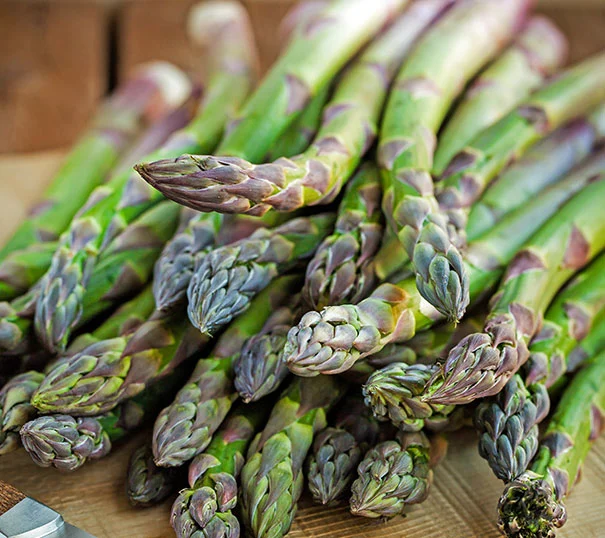
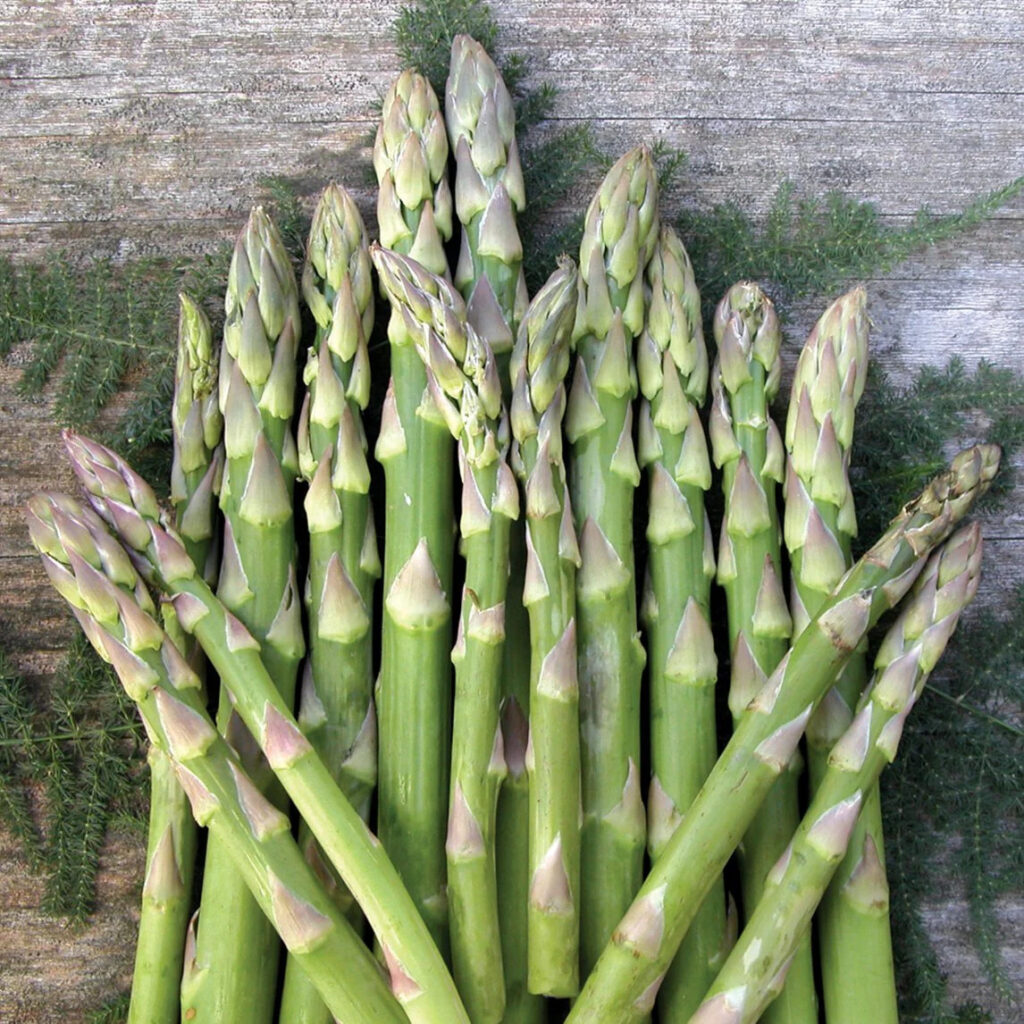
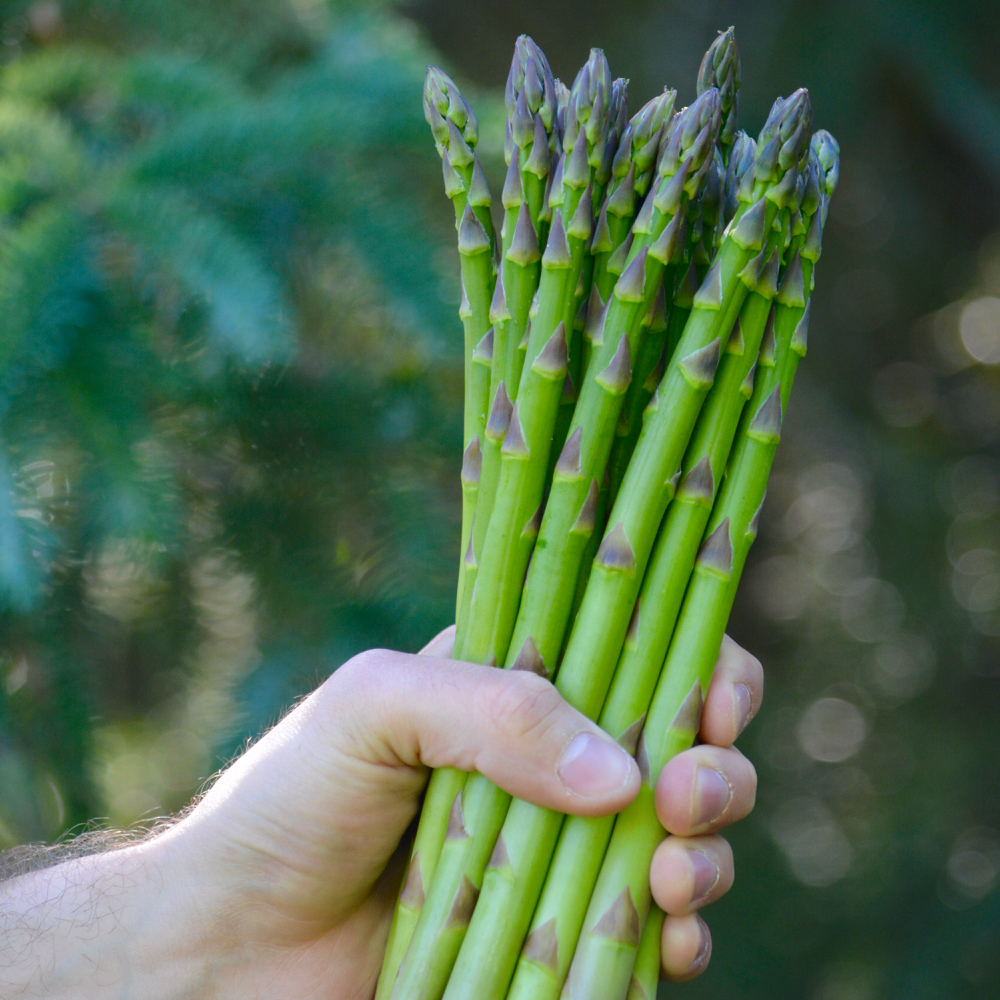
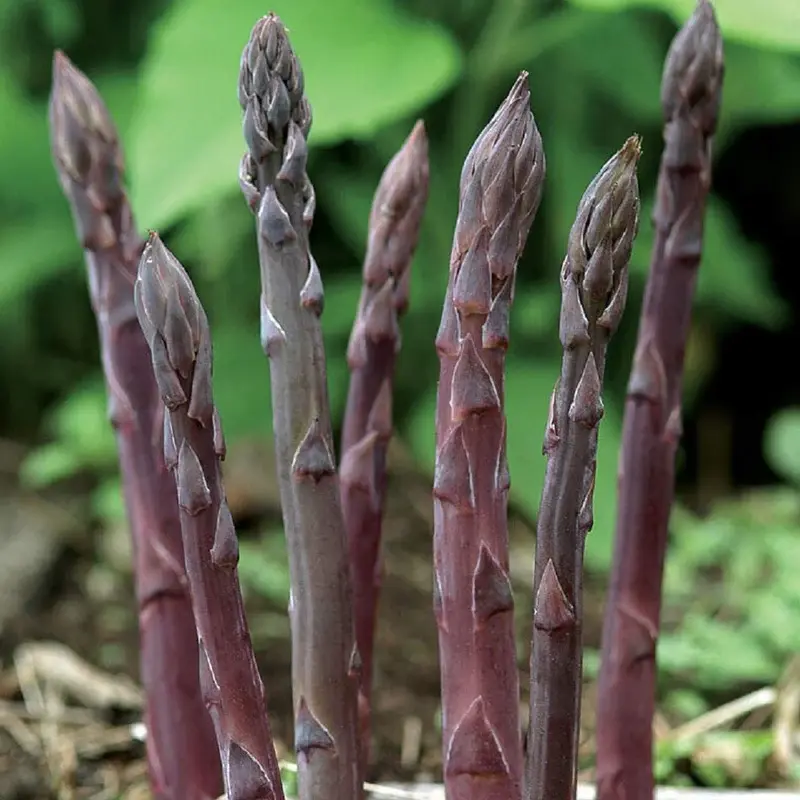
Climate Considerations:
- Cold Climates: Varieties like ‘Guelph Millennium’ are bred for cold tolerance and perform well in northern regions.
- Warm Climates: ‘UC 157’ is a variety developed for warmer climates, making it suitable for southern gardeners.
Growing Asparagus from Seeds
While starting asparagus from seeds is possible, it requires patience and additional time before harvest:
- Pros: Cost-effective and offers a wider selection of varieties.
- Cons: Takes an additional year or more to reach harvestable size compared to crowns.
- Method:
- Timing: Start seeds indoors 12 to 14 weeks before the last expected frost.
- Containers: Use seed trays or small pots filled with seed-starting mix.
- Sowing: Plant seeds about ½ inch deep and space them 1 inch apart.
- Watering: Keep the soil moist but not soggy. Use a spray bottle to avoid displacing seeds.
- Light and Heat: Place the containers in a warm area with temperatures around 70-75°F (21-24°C). Once seeds germinate, move them to a bright location or provide artificial grow lights for 14-16 hours daily.
- Once seedlings grow to about 4-6 inches tall and have several true leaves, transplant them into larger pots or directly into the garden
How to Prepare the Soil for Asparagus?
Proper soil preparation is vital for establishing a healthy and productive asparagus bed. Follow these steps to create optimal soil conditions:
1. Site Selection:
- Sunlight: Choose a location that receives full sun, with at least 8 hours of direct sunlight daily. Avoid areas that may become shaded by trees or structures over time.
- Drainage: Select a site with well-drained soil to prevent waterlogging, which can lead to root diseases. Raised beds are beneficial in areas with poor drainage.
2. Soil Testing:
- pH Level: Conduct a soil test to determine the pH and nutrient levels. Asparagus prefers a pH between 6.5 and 7.5. Lime can be added to raise pH if necessary.
- Nutrient Assessment: The soil test will reveal nutrient deficiencies. Amend the soil based on test recommendations to ensure balanced fertility.
3. Soil Amendment:
- Organic Matter: Incorporate 2 to 3 inches of well-rotted manure or compost into the top 12 inches of soil. This improves soil structure, fertility, and drainage.
- Phosphorus Fertilizer: Asparagus has a high demand for phosphorus, especially during establishment. Incorporate a phosphorus-rich fertilizer, such as bone meal, into the soil before planting.
4. Bed Preparation:
- Depth: Asparagus plants develop extensive root systems that benefit from ample vertical space. A raised bed should be at least 12 inches deep to accommodate root growth, though depths of 18 to 24 inches are preferable for optimal development and ease of maintenance.
- Width: A bed width of 3 to 4 feet allows for easy access from both sides without compacting the soil, facilitating planting, maintenance, and harvesting activities.
How to Plant Asparagus: Step-by-Step Guide
Step 1: Planting the Crowns
- Soak Crowns: Before planting, soak the crowns in lukewarm water for 15 to 30 minutes to rehydrate the roots.
- Trench Preparation: Create trenches 12 to 18 inches wide and 6 to 8 inches deep. Space trenches at least 3 feet apart to allow for mature plant spread.
- Crown Placement:
- Within each trench, create small mounds of soil spaced 12 to 18 inches apart.
- Position each asparagus crown atop a mound, draping the roots evenly over the sides. Ensure the buds are facing upward to promote proper spear emergence.
- Backfilling:
- Initially, cover the crowns with 2 to 3 inches of soil.
- As shoots emerge and grow, gradually add soil to the trench, eventually filling it to the original soil level. This method encourages robust stem support and root establishment.
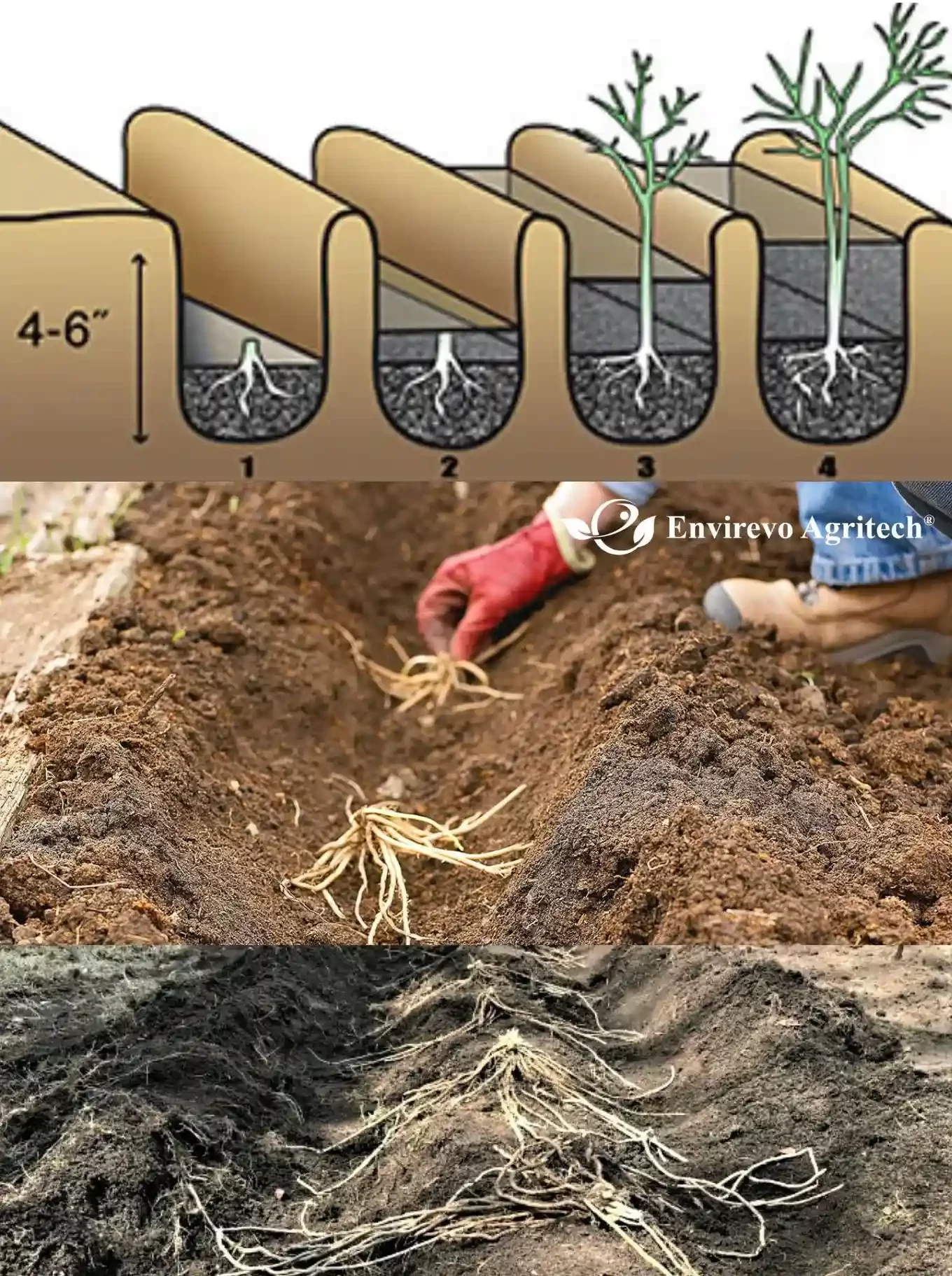
Step 2: Spacing Considerations
- In-row Spacing: Space crowns 12 to 18 inches apart within the row. Closer spacing can lead to higher-density plantings but may result in thinner spears, while wider spacing allows for thicker spear development.
- Between-Row Spacing: Maintain 3 to 6 feet between rows to facilitate air circulation and ease of access for maintenance tasks.
Step 3: Watering and Mulching
- Watering: Provide consistent moisture, especially during the establishment phase. However, avoid overwatering, as waterlogged conditions can lead to root rot. Asparagus requires about 1 inch of water per week during the growing season.
- Mulching: Apply a 2-inch layer of organic mulch, such as straw or shredded leaves, after planting. Mulching helps retain soil moisture, suppress weeds, and regulate soil temperature, creating a more favorable environment for asparagus growth.
By following these steps, you’ll establish a healthy asparagus bed that will provide delicious harvests for many years. For a visual demonstration of the planting process, you may find the following video helpful:
How To Care for Asparagus Plants
Caring for asparagus plants involves consistent maintenance to ensure their health and productivity. Key practices include:
- Watering: Provide approximately 1 inch of water per week during the growing season, adjusting for rainfall. Avoid overwatering to prevent root rot.
- Mulching: Apply a 2-inch layer of organic mulch, such as straw or shredded leaves, to retain soil moisture, suppress weeds, and regulate temperature.
- Fertilization: Incorporate a balanced fertilizer in early spring before new growth, and again after harvest to support fern development.
- Weed Control: Regularly remove weeds by hand to reduce competition for nutrients and water. Avoid mechanical tools that may damage shallow roots.
- Fern Management: Allow ferns to grow after harvest; they photosynthesize and strengthen the root system. Cut back ferns to ground level after they turn brown in late fall or early winter.
Common Pests and Diseases of Asparagus
Asparagus is susceptible to several pests and diseases that can impact yield and plant health. Common issues include:
- Asparagus Beetles: These pests feed on spears and ferns, causing scarring and defoliation. Handpick beetles and larvae, and remove plant debris to reduce overwintering sites. Beneficial insects, such as ladybugs, can help control populations.
- Cutworms: Nocturnal larvae that sever young spears at soil level. Implement cultural controls like removing plant debris and using collars around young plants.
- Fusarium Crown and Root Rot: A soil-borne fungal disease causing yellowing ferns and plant decline. Prevent by planting disease-resistant varieties and avoiding overharvesting. Ensure proper site selection and crop rotation to reduce incidence.
- Asparagus Rust: A fungal disease identified by orange pustules on stems and ferns, leading to reduced vigor. Control by planting resistant varieties, removing infected plant material, and ensuring adequate spacing for air circulation.
- Purple spot: Purple spot is a fungal disease that affects asparagus plants, causing sunken, oval-shaped lesions that are purple or purple-brown in color
- Japanese beetles: Japanese beetles are pests that can significantly damage asparagus plants. They feed on the leaves, causing skeletonization and reducing the plant’s vigor and yield.
- Asparagus aphids: Particularly affecting the tips of the spears where they feed. These aphids suck sap from the plants and can spread diseases. While feeding, they produce a sugary substance called honeydew, which attracts ants and other insects.
Harvesting Asparagus: When and How to Do It
Harvesting asparagus at the right time and using proper techniques ensures optimal spear quality and plant longevity.
- Timing for Harvest:
- First harvest opportunity: Second spring after planting crowns.
- For seed-grown asparagus: Additional year needed for readiness.
- Begin harvesting in the third year after planting to allow plants to be established. Harvest spears when they are 6 to 10 inches tall.
- Duration: In the third year, limit harvesting to 2-3 weeks. In subsequent years, extend the period to 6-8 weeks, typically from early spring to early summer.
- Initial Harvest: Limit to 2-3 spears per plant during the first harvest.
- Subsequent Harvests:
- Harvest pencil-thick spears (6-8 inches tall).
- Continue harvesting while spears are over 3/8 inch in diameter.
- Stop harvesting when most new spears are small and bud tips begin to open.
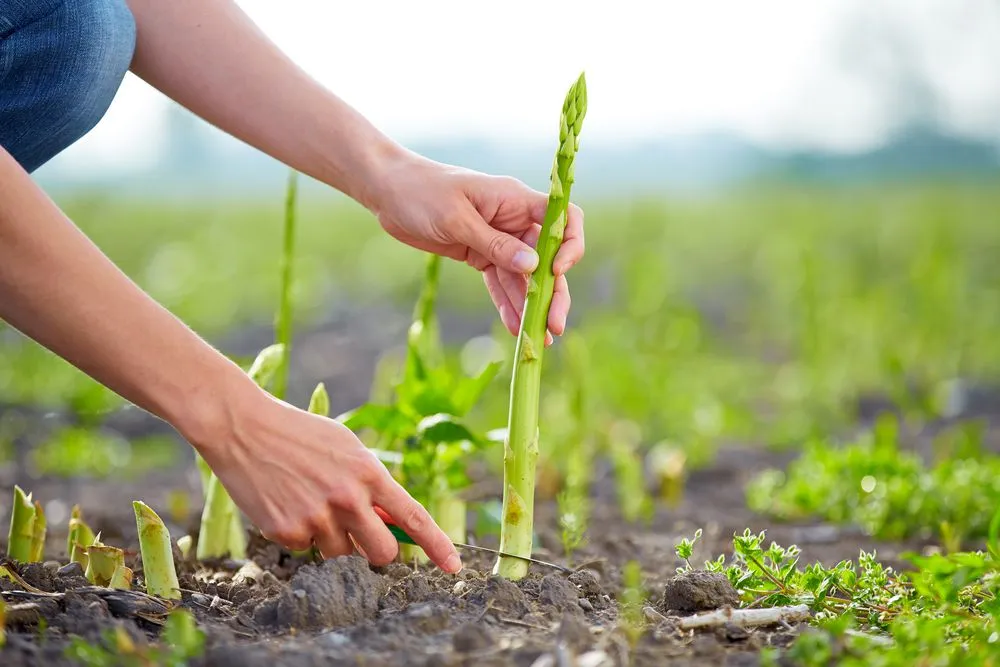
- Harvesting Technique:
- Cut spears at ground level with a sharp knife or snap them off by hand. Harvest spears every 1-3 days during peak season to encourage continued production.
- Avoid cutting the tough, woody lower part of the spear.
- Freshness: Best enjoyed fresh from the garden; serve on the day of harvest or as soon as possible.
- End of Growing Season Care:
- Cut back ferny growth that turns brown and stiff by fall.
- Leave cut growth as mulch.
- Check soil pH and add compost or amendments as needed.
- Cover bare soil with straw or shredded leaf mulch after maintenance.
How to Store Fresh Asparagus
Proper storage and utilization of fresh asparagus are essential to maintain its quality and maximize its culinary potential.
Storing Fresh Asparagus
To keep asparagus fresh and crisp, consider the following methods:
- Refrigeration in Water: Trim about half an inch from the asparagus stems and place the spears upright in a jar or glass with an inch of water at the bottom. Loosely cover the tops with a plastic bag and store in the refrigerator. This method can keep asparagus fresh for up to a week.
- Damp Paper Towel Method: Wrap the stem ends of the asparagus in a damp paper towel and place the bundle inside a plastic bag or airtight container before refrigerating. This technique helps retain moisture and keeps the asparagus fresh for several days.
Troubleshooting Tips for Growing Asparagus
Cultivating asparagus can present challenges. Here are common issues and their solutions:
- Yellowing Plants and Leaves: Overwatering and poor drainage can cause yellowing. Allow soil to dry to a depth of 4 inches before watering again. Check soil pH; add lime if the pH is below 6.5.
- Spears or Ferns Appear Discolored: This can be due to various factors, including pest infestations or nutrient deficiencies. Regularly inspect plants for pests and ensure balanced fertilization.
- Malformed or Deformed Spears: Environmental stressors, such as temperature fluctuations or pest damage, can lead to misshapen spears. Maintain consistent care practices and monitor for pests to mitigate this issue.
- Pest Infestations: Common pests include asparagus beetles, which can damage spears and ferns. Handpick beetles and larvae, and remove plant debris to reduce overwintering sites. Beneficial insects, such as ladybugs, can help control populations.
- Diseases: Asparagus is susceptible to diseases like rust and Fusarium crown and root rot. Implement good cultural practices, such as crop rotation and proper sanitation, to prevent these diseases.
By implementing these storage methods and troubleshooting tips, you can enjoy fresh asparagus in your culinary endeavors and maintain a healthy, productive asparagus garden.
For a visual guide on common mistakes to avoid when growing asparagus, you may find the following video helpful:
FAQs About growing asparagus
How long does it take to grow asparagus?
It takes about 2-3 years for asparagus to establish and produce a full harvest.
Does asparagus regrow after cutting?
Yes, asparagus spears regrow throughout the harvest season as long as the plant is healthy.
What is the secret to growing asparagus?
The secret is to plant asparagus in well-drained, nutrient-rich soil, maintain consistent care, and allow ferns to grow after harvest for energy storage.
What not to plant next to asparagus?
Avoid planting potatoes, onions, garlic, and carrots, as they compete for nutrients and disturb asparagus roots.
Is asparagus better in ground or raised beds?
Asparagus grows well in both, but raised beds offer better drainage, making them ideal for areas with heavy or compacted soil.
Does asparagus regrow after cutting?
Yes, asparagus spears will regrow throughout the season if properly harvested and cared for.
That’s It
Successfully growing asparagus demands patience and meticulous care, but the rewards are substantial. By choosing appropriate varieties, preparing the soil adequately, and adhering to proper planting and maintenance practices, gardeners can establish a thriving asparagus bed that yields high-quality spears year after year. With consistent attention to detail and proactive management of pests and diseases, asparagus cultivation can be a gratifying endeavor, offering fresh, homegrown spears for a variety of culinary uses.
